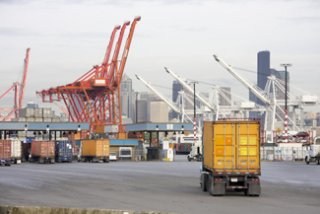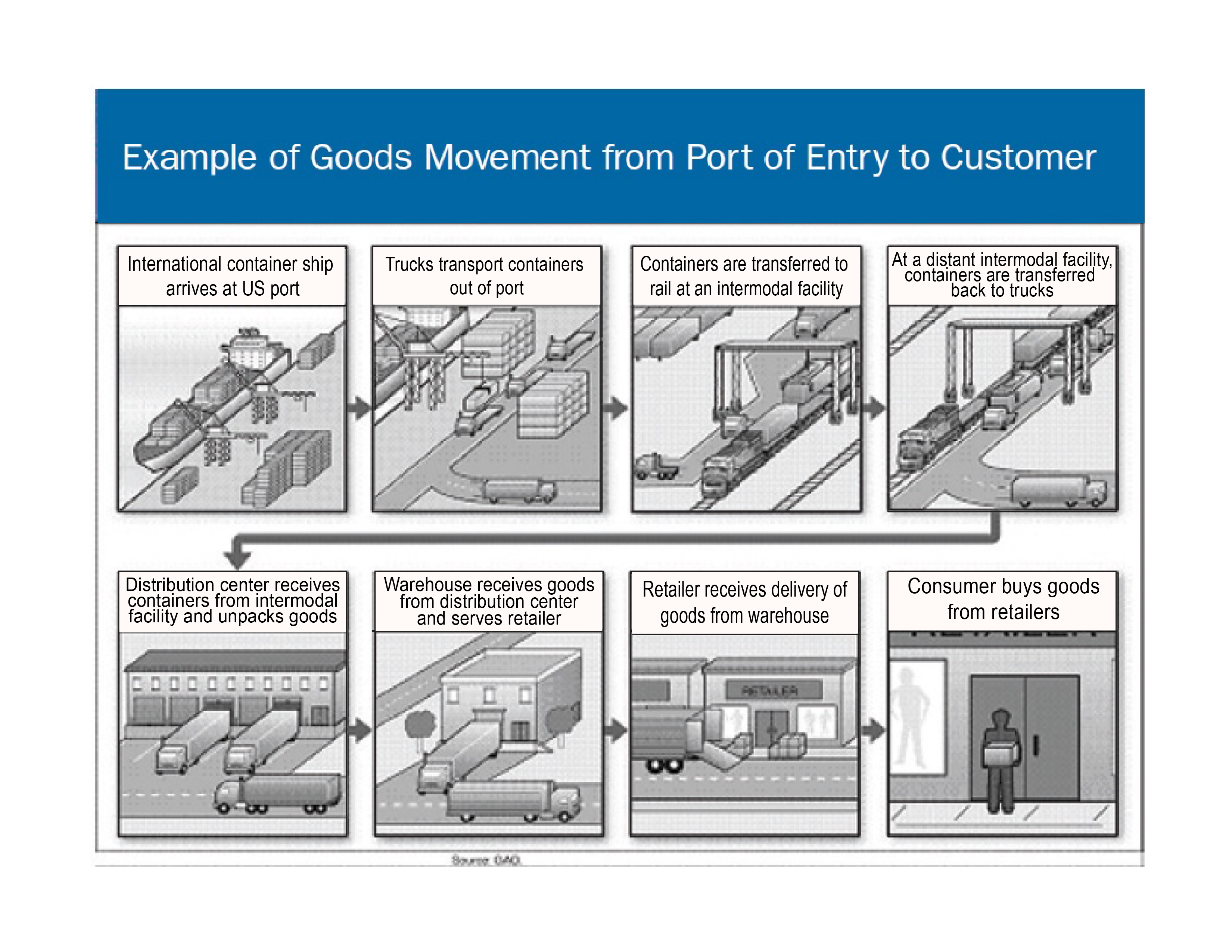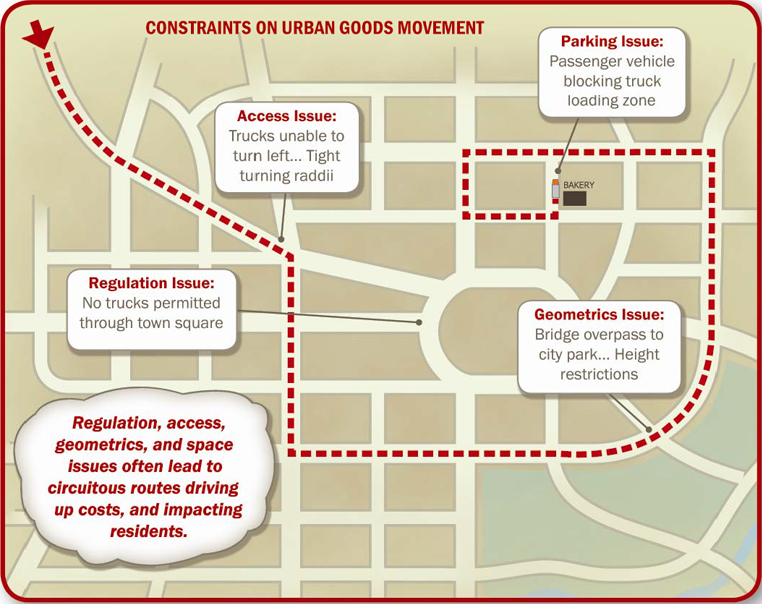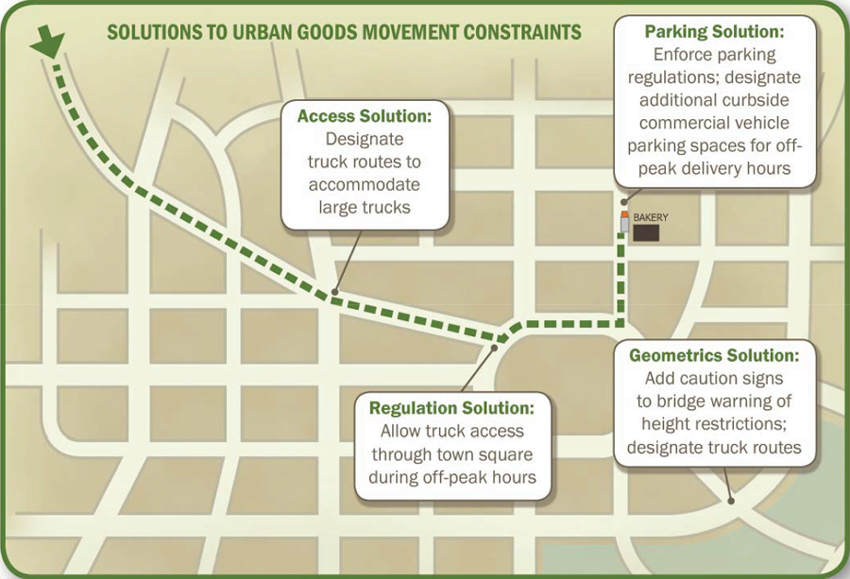Ports Primer: 5.1 Goods Movement and Transportation Planning
Goods movementThe distribution of freight (including raw materials, parts and finished consumer products) by all modes of transportation including marine, air, rail and truck. is an integral aspect of port operations and planning. The transportation system helps move freightMerchandise hauled by transportation lines. from its source of production to points of consumption.
Communities and businesses around the world gain economic benefits from the ability to buy and sell their goods in distant markets. The movement of goods through ports often directly impacts communities next to these facilities. Near-port communities can be disproportionately impacted by goods movement because of the cumulative impact of the many types of freight facilities that may converge at ports.
Freight facilities may include:1
- Seaports, airports and border crossings
- Railyards and rail lines
- Marine highways
- Highways and high truckHeavy automotive vehicles used to transport cargo. In the maritime industry, cargo is often carried by tractor-trailers. The tractor is the front part of the vehicle, also called a cab. The trailer is the detachable wheeled chassis behind the tractor, on which containers or other cargoes are placed. traffic roads
- Warehouse and distribution facilities
Transportation Planning and Coordination

Transportation planning is critical for effective operations at ports. If goods cannot get into or out of a port facility efficiently, this bottleneck can slow port operations and increase air pollution. Therefore, agencies involved in planning of different modes of transportation must coordinate to improve the flow of goods to and from ports while also achieving transportation goals of the local community.2
Government entities involved in transportation planning can include:
- Local transportation planning departments
- Metropolitan planning organizations
- State and federal departments of transportation
- Port authorities
- State and local environmental agencies
Goods Movement and Supply Chains
Goods movement The distribution of freight (including raw materials, parts and finished consumer products) by all modes of transportation including marine, air, rail and truck.:3 the distribution of freight (including raw materials, parts and finished consumer products) by all modes of transportation including marine, air, rail and truck.
Supply ChainA network that supplies goods or services from the source of production through the point of consumption. A supply chain is considered to include people, organizations, transportation infrastructure, information technology and physical locations such as manufacturing plants, distribution centers, and retail outlets.:4 a group of human and physical entities including procurement specialists, wholesalers, logistics managers, manufacturing plants, distribution centers and retail outlets, linked by information and transportation in a seamless, integrated network to supply goods or services from where it is produced to where it is consumed.
The figure below illustrates an example of goods movement from a port of entry to the customer (security measures at port not included but important).

Local Transportation Regulations
Regulations can help improve the safety and efficiency of goods movement. This benefits all stakeholders, including those entities involved in the supply chain and those communities impacted by it. Regulations that can improve safety and efficiency include:
- Urban design standards (e.g., truck turning radius, height clearances)
- Land use and zoning (e.g. location of freight facilities, parking and loading zones, delivery windows/time of day restrictions)
- Urban truck regulations (e.g. designated truck routes, truck size and weight regulations)
- Idling reductions
Example Truck Route Scenario: Challenges5
The following map illustrates a scenario where circuitous driving routes have led to increased costs for trucking companies and impacts on a residential community. This map illustrates the problems creating this outcome. Click this link for potential solutions (Example Truck Route Scenario: Solutions).

Example Truck Route Scenario: Solutions6
The following map illustrates potential solutions in a scenario where circuitous driving routes have led to increased costs for trucking companies and impacts on a residential community. This map illustrates solutions that can help create better outcomes, which benefit both the trucking companies and the community. (To view the original scenario, click this link for Example Truck Route Scenario: Challenges.)

The Role of Metropolitan Planning Organizations7

A Metropolitan Planning Organization (MPO) coordinates regional transportation policy making and planning efforts. MPOs can be found in urban areas with populations greater than 50,000. MPOs provide numerous functions including:
- Acting as a channel for federal funding for transportation projects
- Providing a forum for regional decision-making
- Conducting transportation planning studies to evaluate alternative transportation project options
- Developing a long-range Metropolitan Transportation Plan
- Developing a short-range Transportation Improvement Program
- Conducting public engagement around transportation planning
Through the public involvement process, near-port communities may be able to provide feedback on transportation planning considerations and influence transportation policies and projects.8
Additionally, MPOs located in metropolitan areas that have been designated as nonattainment areas (NAA) or are in maintenance status are responsible for developing and coordinating transportation plans that are consistent with the air quality plan for the area. More detailed information on this role of MPOs is provided in the Environmental Impacts section of this document.
It is important to note that states are also responsible for an increasing share of funding for transportation projects and should be considered in conjunction with the MPO.
For more information: The Transportation Planning Process
To find your local MPO: MPO Database











